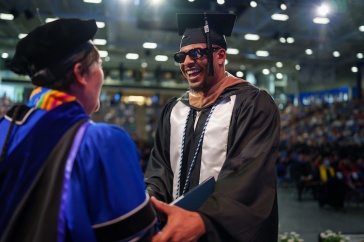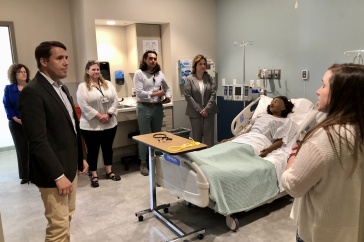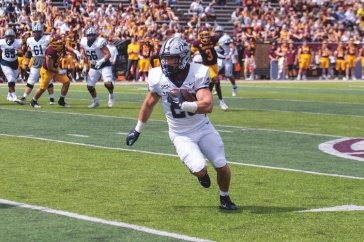
When the NFL wanted to evaluate the impact of non-standard facemasks on player safety, they turned to UNH kinesiology professor Erik Swartz for the data. His findings led to the league’s much-reported recent banning of overbuilt facemasks for the coming football season.
Swartz, who teaches in the athletic training option and does research on football helmets and other equipment, serves on the NFL’s Head, Neck, and Spine Safety Equipment and Rules Subcommittee. With the modest proliferation of overbuilt facemasks – sometimes called Bane or Shredder masks after characters from Batman and Teenage Mutant Ninja Turtles, respectively – the league tapped Swartz to assess the pros and cons.
With more bars providing greater coverage from the nose down, the masks were popularized by players like Justin Tuck of the Oakland Raiders for their perceived enhanced protection. “There was the thought that these masks would decrease the chance that you’d be able to stick a finger through and poke the player, or to grab the mask and twist it and hurt the neck,” says Swartz.
But after testing the helmets with overbuilt facemasks in his New Hampshire Hall laboratory and in a national impact testing facility, Swartz found that instead of reducing risk of injury, the facemasks potentially increased the risk. Not only could the added weight of the facemask compromise the structural integrity of the helmet, it shifts the head’s center of gravity forward, possibly resulting in fatigue to neck muscles and riskier tackling posture. Swartz also found that an opposing player’s finger could get stuck in the smaller spaces of the facemask – accidentally or not – and result in serious injury to the opponent’s finger and the player’s neck.
“While it may seem logical that adding additional bars to a football facemask would make it more protective, our research suggests that overbuilt facemasks could actually increase the risk of injury to both the player wearing it as well as to other players on the field,” he concluded in his report to the NFL.
Swartz notes that although only a handful of NFL players were using the non-standard facemasks, the ruling could have a trickle-down effect to college and high school players, where the intimidating-looking facemasks are more common.
Watch a video of Swartz testing football equipment in the lab: https://www.youtube.com/watch?v=8z8EYXOXIuM&list=PLE053CD41274F2420
Originally published by:
UNH Today
-
Written By:
Beth Potier | UNH Marketing | beth.potier@unh.edu | 2-1566





















































